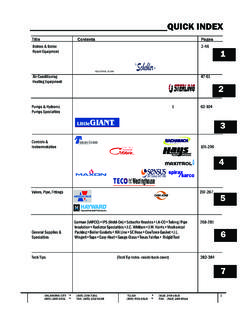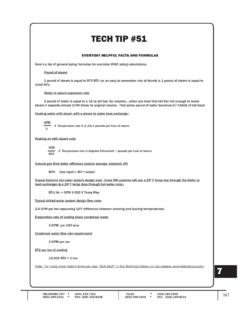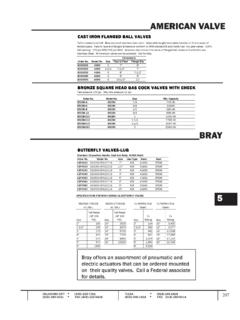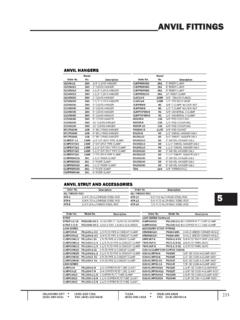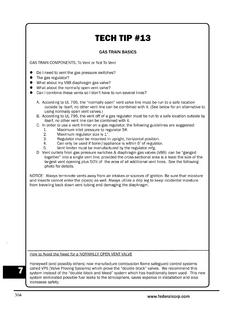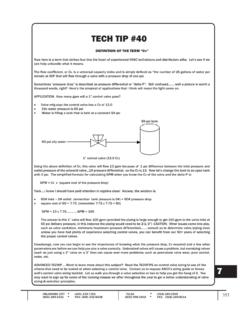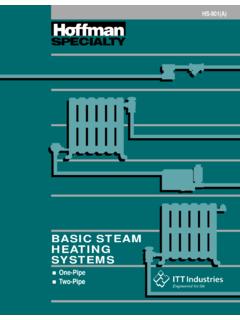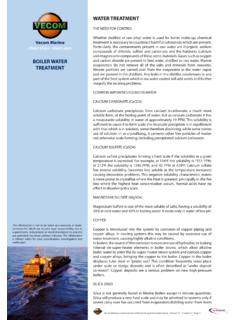Transcription of TECH TIP #18
1 TIP #18 WATER LEVEL CONTROLS FOR STEAM BOILERSS team BoilersThey ve been with us for over two hundred years, and most of the time they re so reliable most folks don t give them much thought. They sit in buildings all over the world, transferring heat from fuel to water, allowing us to warm our buildings or complete our boilers are simple, efficient and reliable. No machine does a better job of moving BTUs from one place to another. We ve used them for space heating since before the United States Civil War in before the Civil War, we used steam boilers for industrial processes.
2 Today we use them to run factories, press clothes, wash dishes, pasteurize milk, sterilize medical equipment, and to heat entire cities! Their capabilities seem despite its simplicity, any steam boiler can run into trouble if its control system doesn t act properly. If the energy you put into the boiler exceeds what the boiler can absorb, the boiler can rupture. So you must always be on simple safety relief valve of the right capacity and relief-pres-sure setting protects the boiler from over pressure.
3 But over pressure isn t the only thing that can threaten a steam boiler . There are also the dangers of dry the internal water level drop too low, the boiler can burn out. So here too, you must always be on guard. You see, a steam boiler needs its water to move the heat away from its metal surfaces. Without the right internal level of water, heat quickly accumulates. Too much heat creates a very dangerous operating condition. OKLAHOMA CITY (405) 239-7301 TULSA (918) 249-1918 (800) 289-3331 FAX: (405) 232-5438 (800) 955-1918 FAX: (918) 249-9014 3177 tech TIP #18 (Cont.)
4 boiler manufacturers have always set up minimum safe water level requirements for their equipment. Our controls help enforce those requirements in two ways: By maintaining a minimum safe water level in the boiler . By signaling the burner to stop should the water level drop below that this brief Systems Guide we will explain how we do these two very important s a Normal Water Level?The proper steam boiler water level varies from manufacturer to manufacturer, but generally we can say that it s normal to start by manually filling the boiler to the two-thirds-full point on the gauge glass.
5 As the boiler operates, the water will quickly turn to steam and head out toward the takes place at a constant rate of about one-half gpm per 240,000 BTU/HR ( heating capacity rating). This is a law of physics, so it doesn t vary from manufacturer to manufacturer. If you re working with a boiler with a rating of say 1,000,000 BTU/HR, you can be assured the water is turning to steam and leaving that boiler at the rate of about two gpm. And it s leaving at speeds measured in miles per hour (sometimes exceeding 60 mph!)
6 So it s very important for your near- boiler piping to be correct. If it s not, the fast moving steam will pull water out of the boiler and create problems for you in the system and the the water (in the form of steam) heads out toward the system, the water level in the boiler will, of course, drop. How far it drops depends a lot on the size and condition of your piping system. You see, ideally, the water should begin to return to the boiler before the boiler s internal water line drops to a critical point.
7 That s the point at which the low water cut-off will cut power to the burner, or an automatic water feeder will the water is in the system piping and radiating during operation, the normal water level becomes a point that s somewhere in the lower-third of the gauge that you re working with a range of operation here, not a fixed point. If the water were to stay at the top of the gauge glass all the while the burner was firing, you probably wouldn t be making steam! So don t get too caught up with the word normal because the only thing that s normal is that the water level will rise and manufacturers, as we said before, do establish a mini-mum safe water level for their boilers, however.
8 That point usually just out of sight of the bottom of the gauge glass. Should the water level drop to this point, the boiler may be in danger of overheating. We have to find a way to protect the boiler from leading authorities and insurance companies recognize this need. The ASME Code for Low Pressure Heating Boil-ers, for instance, specifies, Each automatically fired steam or vapor steam boiler shall be equipped with an automatic low water fuel cut-off. The device the code refers to is what most people in the field commonly call a low water cut-off.
9 Its job is to stop the burner and protect the Causes a Low Water Condition?Because it s an open system, some evaporative water loss is normal for a steam system. How much depends on the size and condition of the system. If you re losing too much water, however, it s time to begin troubleshooting. There are many places to lookHere are a few good places to start: The air vents are dirty, not seating properly, and passing steam to the atmosphere. Someone left the boiler blowdown valve partially open. Someone, for whatever reason, has been drawing hot water from the boiler .
10 The relief valve has discharged. The condensate pump isn t working as it The float may have come The condensate may be too hot to pump. (Check those steam traps!) Improper near- boiler piping may be throwing water up into the system, or causing the waterline to tilt during operation. The wet returns may be leaking. (Always suspect any buried pipe). A check valve may be stuck closed or partially closed. The boiler may be foaming and Check the pH of the water. It should be between 7 tech TIP #18 (Cont.)


